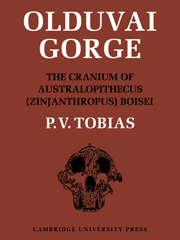Book contents
- Frontmatter
- Contents
- List of text-figures
- List of plates
- List of tables
- Introductory Note
- Foreword
- Editor's Note
- Acknowledgements
- I Introduction
- II Preservation and reconstruction of the cranium
- III The cranial vault
- IV The basis cranii externa
- V Certain critical angles and indices of the cranium
- VI The interior of the calvaria
- VII The thickness of the cranial bones
- VIII The endocranial cast of Zinjanthropus
- IX Metrical characters of the calvaria as a whole
- X The structure of the face
- XI The pneumatisation of the Zinjanthropus cranium
- XII The dental arcade and the palate
- XIII The pattern of dental attrition and occlusion, with comments on enamel hypoplasia
- XIV The size of individual teeth, absolute and relative
- XV The size of the dentition as a whole
- XVI The crown shape index of the teeth
- XVII The morphology of the teeth
- XVIII Summary of cranial and dental features of Zinjanthropus
- XIX The taxonomic status of Zinjanthropus and of the australopithecines in general
- XX The cultural and phylogenetic status of Australopithecus boisei and of the australopithecines in general
- References
- Index of persons
- Index of subjects
- Plate section
V - Certain critical angles and indices of the cranium
Published online by Cambridge University Press: 05 November 2011
- Frontmatter
- Contents
- List of text-figures
- List of plates
- List of tables
- Introductory Note
- Foreword
- Editor's Note
- Acknowledgements
- I Introduction
- II Preservation and reconstruction of the cranium
- III The cranial vault
- IV The basis cranii externa
- V Certain critical angles and indices of the cranium
- VI The interior of the calvaria
- VII The thickness of the cranial bones
- VIII The endocranial cast of Zinjanthropus
- IX Metrical characters of the calvaria as a whole
- X The structure of the face
- XI The pneumatisation of the Zinjanthropus cranium
- XII The dental arcade and the palate
- XIII The pattern of dental attrition and occlusion, with comments on enamel hypoplasia
- XIV The size of individual teeth, absolute and relative
- XV The size of the dentition as a whole
- XVI The crown shape index of the teeth
- XVII The morphology of the teeth
- XVIII Summary of cranial and dental features of Zinjanthropus
- XIX The taxonomic status of Zinjanthropus and of the australopithecines in general
- XX The cultural and phylogenetic status of Australopithecus boisei and of the australopithecines in general
- References
- Index of persons
- Index of subjects
- Plate section
Summary
The planum nuchale: tilt and height
The tilt of the planum nuchale
The planum nuchale of the occipital squama is tilted at only a slight angle to the plane of the foramen magnum which, in turn, is tilted upwards at an angle of 7° to the F.H. (see section on ‘The Plane of the Foramen Magnum’). Thus the planum nuchale of Zinjanthropus is much more horizontal than is that of the Pongidae, in which the nuchal surface rises steeply upwards to the nuchal crest. This low, nearly horizontal planum nuchale is characteristic, too, of Australopithecus (e.g. MLD 37/38 and Sts 5), though in the very unusual and apparently deformed cranium VII from Sterkfontein, the planum is much steeper and more pongid in appearance. Broom and Robinson (1950, p. 25) suggested that this unique feature in Sts VII, which they likened to the effects of artificial deformation on Amerindian crania, was due to ‘slow postmortem crushing without very manifest breaking of the bones’. In Sts VIII, as well, the planum nuchale ‘makes an angle with the main part of the base of the basioccipital of about 49°’ (Broom and Robinson, 1950, p. 28). The latter plane is thus not nearly as horizontal as in Zinjanthropus. Of the Paranthropus crania published, the only ones in which this area is satisfactorily preserved are those of two juveniles from Swartkrans, in which the plane of the nuchal surface is very similar to that in Zinjanthropus (Broom and Robinson, 1952, pp. 26–30).
- Type
- Chapter
- Information
- Olduvai Gorge , pp. 43 - 52Publisher: Cambridge University PressPrint publication year: 1967

